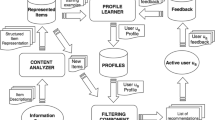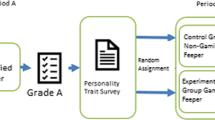Abstract
Recent researches in e-Learning area highlight the need to define novel and advanced support mechanism for commercial and academic organizations in order to enhance the skills of employees and students and, consequently, to increase the overall competitiveness in the new economy world. This is due to the unbelievable velocity and volatility of modern knowledge that require novel learning methods which are able to offer additional support features as efficiency, task relevance and personalization. This paper tries to deal with these features by proposing an adaptive e-Learning framework based on Computational Intelligence methodologies by supporting e-Learning systems’ designers in two different aspects: (1) they represent the most suitable solution, able to support learning content and activities, personalized to specific needs and influenced by specific preferences of the learner and (2) they assist designers with computationally efficient methods to develop “in time” e-Learning environments. Our work attempts to achieve both results by exploiting an ontological representation of learning environment and a hierarchical memetic approach of optimization. In detail, our approach takes advantage of a collection of ontological models and processes for adapting an e-Learning system to the learner expectations by efficiently solving a well-defined optimization problem, through a hierarchical multi-cores memetic approach.
















Similar content being viewed by others
References
Dagger D, O’Connor A, Lawless S, Walsh E, Wade VP (2007) Service-oriented e-Learning platforms: from monolithic systems to flexible services. IEEE Internet Comput 11:28–35
Gruber T (1995) Toward principles for the design of ontologies used for knowledge sharing. Int J Hum Comput Stud 43:907–928
Dichev C, Dicheva D (2006) Using contexts to personalize educational topic maps. Adaptive Hypermedia and Adaptive Web-Based Systems. In: Proceedings of 4th international conference, AH 2006, Dublin, Ireland, June 21–23, Lecture Notes in Computer Science 4018 Springer 2006, pp 269–273
Gu Q, Sumner T (2006) Support personalization in distributed e-learning systems through learner modeling. In: 2nd international conference on information and communication technologies 2:610–615
Cormen ITH, Leiserson CE, Rivest RL, Stein C (2001) Introduction to algorithms, 2nd edn. McGraw-Hill, Boston
Krarup J, Pruzan PM (1983) The simple plant location problem: survey and synthesis. Eur J Oper Res 12:36–57
Whitley D, Starkweather T (1990) GENITOR II: a distributed genetic algorithm. J Exp Theor Artif Intell 2:189–214
IEEE Learning Technology Standard. WG12: learning object metadata. http://ltsc.ieee.org/wg12
Aroyo L, Pokraev S, Brussee R (2003) Preparing SCORM for the semantic web. In: Proceedings of on the move to meaningful internet systems 2003: Coopis, DOA, and ODBASE, Catania Sicily, Italy, LNCS 2888, pp 621–628
Crampes M, Ranwez S (2000) Ontology-supported and ontology-driven conceptual navigation on the world wide web. In: 11th ACM hypertext conference, pp 191–199
Qu C, Gamper J, Neidl W (2001) A collaborative courseware generating system based on WebDAV, XML, and JSP. In: Proceedings of IEEE international conference on advanced learning technologies, pp 197–198
Chen W, Hayashi Y, Jin L, Mitsuru I, Mizoguchi R (1998) An ontology-based intelligent authoring tool. In: Proceedings of the 6th international conference on computers in education. Beijing, China, pp 41–49
Santos JM, Anido L, Llamas M (2003) On the use of e-learning standards in adaptive learning systems. In: Proceedings of the 3rd IEEE international conference on advanced learning technologies, pp 480–481
Mizogushi R, Kitamura Y (2002) Ontology-based systematization of functional knowledge. J Eng Des 15:327–351
Lee CS, Wang MH, Chen LL (2008) Ontology-based intelligent decision support agent for CMMI project monitoring and control. Int J Approx Reason 48:62–76
Yager RR, Petry FE (2006) A multicriteria approach to data summarization using concept ontologies. IEEE Trans Fuzzy Syst 14:767–780
Lee CS, Jian ZW, Huang LK (2005) A fuzzy ontology and its application to news summarization. IEEE Trans Syst Man Cybern Part B 35:859–880
Bechhofer S, Yesilada Y, Stevens R, Jupp S, Horan B (2008) Using ontologies and vocabularies for dynamic linking. IEEE Internet Comput 12:32–39
Lee CS, Chang YC, Wang MH (2009) Ontological recommendation multi-agent for Tainan city travel. Expert Syst Appl 36:6740–6753
Reformat M, Ly C (2009) Ontological approach to development of computing with words based systems. Int J Approx Reason 50:72–91
Devedic V, Jovanovic J, Gaevic D (2007) The pragmatics of current e-Learning standards. IEEE Internet Comput 1:19–27
Simington B (2006) Blended learning—neither shaken nor stirred. In: Proceedings of the 17th annual SEMI/IEEE advanced semiconductor manufacturing conference, pp 358–361
El Alami A, Casel N, Zampunieris D (2007) An architecture for e-Learning system with computational intelligence, LNAI 4693, KES 2007/WIRN 2007. In: Apolloni B (ed) Springer, pp 58–65
Alexakos CE, Giotopoulos KC, Thermogianni EJ, Beligiannis GN, Likothanassis SD (2006) Integrating e-Learning environments with computational intelligence assessment agents, World Academy of Science. Eng Technol 13:233–238
Buraga S (2003) Developing agent-oriented e-Learning systems. In: Dumitrache, Buiu C (eds) Proceedings of the 14th international conference on control systems and computer science, vol 2, I. Politehnica, pp 235–241
Angehrn A, Nabeth T, Razmerita L, Roda C (2001) K-inca: using artificial agents for helping people to learn new behaviors. In: Proceedings of the IEEE international conference on advanced learning technologies (ICALT 2001), Madison, USA, pp 225–226
Zaiane OR (2002) Building a recommender agent for e-Learning systems. In: Proceedings of the international conference on computers in education, Auckland, New Zealand, pp 55–59
He L, Mort N (2000) Hybrid genetic algorithms for telecommunications network back-up routing. BT Technol J 18:42–56
Fleurent C, Ferland J (1993) Genetic hybrids for the quadratic assignment problem. In: DIMACS series in discrete mathematics and theoretical computer science. American Mathematical Society, Providence, pp 173–187
Merz P (2000) Memetic algorithms for combinatorial optimization problems: fitness landscapes and effective search strategies, PhD dissertation, Parallel Syst Res Group, Department of Electrical Engineering and Computer Science, University of Siegen, Siegen, Germany
Morri GM, Goodsell DS, Halliday RS, Huey R, Hart WE, Belew RK, Olson AJ (1998) Automated docking using a Lamarkian genetic algorithm and an empirical binding free energy function. J Comput Chem 14:1639–1662
Ku K, Mak M (1998) Empirical analysis of the factors that affect the Baldwin effect. In: Proceedings of parallel problem solving from nature—PPSN-V, Springer, Berlin, pp 481–490
Jing T, Lim MH, Ong YS (2003) A parallel hybrid GA for combinatorial optimization using grid technology. In: Proceedings of IEEE congress on evolutionary computation, 2003. CEC ’03, vol 3, pp 1895–1902
Jing T, Lim MH, Ong YS (2007) Diversity-adaptive parallel memetic algorithm for solving large scale combinatorial optimization problems. Soft Comput 11:873–888
Nowostawski M, Poli R (1999) Parallel genetic algorithm taxonomy. In: Lain LC (ed) Proceedings of the third international conference on knowledge-based intelligent information engineering systems (KES’99), Adelaide, August 1999, pp 88–92
Liu Z, Liu A, Wang C, Niu Z (2004) Evolving neural network using real coded genetic algorithm (GA) for multispectral image classification. Future Gener Comput Syst 20:1119–1129
Cui J, Fogarty TC, Gammack JG (1993) Searching databases using parallel genetic algorithms on a transputer computing surface. Future Gener Comput Syst 9:33–40
Sena GA, Megherbi D, Isern G (2001) Implementation of a parallel genetic algorithm on a cluster of workstations: traveling salesman problem, a case study. Future Gener Comput Syst 17:477–488
Cant-Paz (1998) A survey of parallel genetic algorithms. Calculateurs Paralleles. Reseaux et Systems Repartis 10:141–171
Albano G, Gaeta M, Salerno S (2006) e-Learning: a model and process proposal. Int J Knowl Learn 2:73–88
Koper R (2006) Current research in learning design. Educ Technol Soc J 9:13–22
Guarino N (1998) Formal ontology and information systems. In: Proceedings of FOIS98, Trento, Italy, 6–8 June 1998. Amsterdam, IOS Press, pp 3–15
Kopcha TJ, Sullivamn H (2008) Learner preferences and prior knowledge in learner-controlled computer-based instruction. Educ Technol Res Dev 56:265–286
ADOBE FLASH CS4 PROFESSIONAL, http://www.adobe.com/products/flash/
The Official Microsoft Silverlight Site, http://silverlight.net/
Intelligent Web Teacher, http://www.momanet.it/english/iwt_eng.html (URL)
Albano G, Gaeta M, Ritrovato P (2007) IWT: an innovative solution for AGS e-Learning model. Int J Knowl Learn 3:209–224
Acampora G, Gaeta M, Loia V, Ritrovato P, Salerno S (2008) Optimizing learning path selection through memetic algorithms. In: Proceedings of world congress on computational intelligence 2008, WCCI 2008, Hong Kong, China, pp 3869–3875
Learning Technology Standards Committee of the IEEE. Standard for learning objects metadata. Document no: IEEE PAR1484.12.1, url: http://ltsc.ieee.org/wg12/files/LOM_1484_12_1_vf1_Final_Draft.pdf
Devedzic V, Jovanovic J, Gasevic D (2007) The pragmatics of current e-Learning standards. IEEE Internet Comput 11:19–27
Doctor G, Ramachandran S (2007) Learning object repositories: an emerging knowledge management tool for sharing and reusing learning resources. ICFAI J Knowl Manag 5:39–52
Multimedia Educational Resource for Learning and Online Teaching (website). http://www.merlot.org
Canadian Network of Learning Object Repositories (website), http://www.edusource.ca
Australia’s free online network for educators (website), http://www.edna.edu.au
Murugesan S (2007) Understanding Web 2.0, IT Professional, 9:34–41
JGAP: Java Genetic Algorithms Package, http://jgap.sourceforge.net/
Fracture—Java Multi Core Library, http://kccoder.com/fracture/
Acknowledgments
The authors wish to thank the Guest Editor and anonymous reviewers for their valuable comments and helpful suggestions which greatly improved the paper’s quality.
Author information
Authors and Affiliations
Corresponding author
Rights and permissions
About this article
Cite this article
Acampora, G., Gaeta, M. & Loia, V. Hierarchical optimization of personalized experiences for e-Learning systems through evolutionary models. Neural Comput & Applic 20, 641–657 (2011). https://doi.org/10.1007/s00521-009-0273-z
Received:
Accepted:
Published:
Issue Date:
DOI: https://doi.org/10.1007/s00521-009-0273-z




